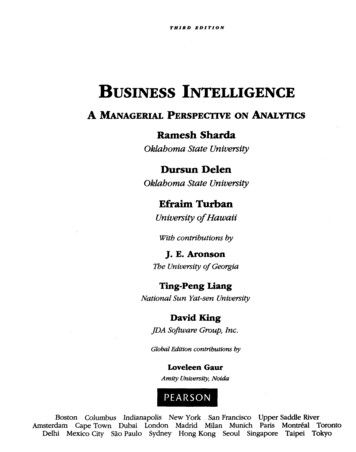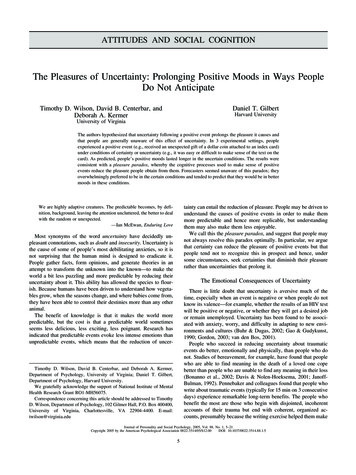
Transcription
Social PsychologyTenth EditionElliot AronsonTimothy D. WilsonSamuel R. SommersA01 ARON1287 10 SE FM.indd 112/2/17 12:08 AM
Portfolio Manager: Kelli StriebyContent Producer: Cecilia Turner/Lisa MafriciContent Developer: Thomas FinnPortfolio Manager Assistant: Louis FierroExecutive Product Marketing Manager: Christopher BrownSenior Field Marketing Manager: Debi DoyleContent Producer Manager: Amber MackeyContent Development Manager: Sharon GearyArt/Designer: Blair BrownDigital Studio Course Producer: Lindsay VergeFull-Service Project Manager: Angel ChavezCompositor: Integra Publishing Services, Inc.Printer/Binder: R. R. Donnelley RoanokeCover Printer: Lehigh Phoenix Color/HagerstownCover Design: Lumina DatamaticsCover Credit: Noma Bar, PentagramCredits and acknowledgments borrowed from other sources and reproduced, with permission, in thistextbook appear on the appropriate page within the text or on pages 545–548.Copyright 2019, 2016, 2013 by Pearson Education, Inc. or its affiliates. All Rights Reserved.Printed in the United States of America. This publication is protected by Copyright and permissionshould be obtained from the publisher prior to any prohibited reproduction, storage in a retrievalsystem, or transmission in any form or by any means, electronic, mechanical, photocopying, recording, or likewise. For information regarding permissions, request forms and the appropriatecontacts, please visit www.pearsoned.com/ permissions for Pearson’s Rights and PermissionsDepartment.PEARSON, ALWAYS LEARNING, and Revel are exclusive trademarks in the U.S. and/or othercountries owned by Pearson Education, Inc. or its affiliates.Unless otherwise indicated herein, any third-party trademarks that may appear in this work arethe property of their respective owners and any references to third-party trademarks, logos orother trade dress are for demonstrative or descriptive purposes only. Such references are not intended to imply any sponsorship, endorsement, authorization, or promotion of Pearson’s productsby the owners of such marks, or any relationship between the owner and Pearson Education, Inc.or its affiliates, authors, licensees or distributors.Library of Congress Cataloging-in-Publication DataNames: Aronson, Elliot, author. Wilson, Timothy D., author. Sommers, Sam,author.Title: Social psychology / Elliot Aronson, Timothy D. Wilson, Samuel R.Sommers.Description: Tenth edition. New York, NY : Pearson, [2019] Includesbibliographical references and index.Identifiers: LCCN 2017037187 ISBN 9780134641287 (softcover : alk. paper)Subjects: LCSH: Social psychology.Classification: LCC HM1033 .A78 2019 DDC 302—dc23LC record available at https://lccn.loc.gov/2017037187118Rental EditionISBN-10:0-13-464128-0ISBN-13: 978-0-13-464128-7Access CardISBN-10:0-13-470064-3ISBN-13: 978-0-13-470064-9Books à la CarteISBN-10:0-13-470066-XISBN-13: 978-0-13-470066-3Instructor’s Review CopyISBN-10:0-13-467840-0ISBN-13: 978-0-13-467840-5A01 ARON1287 10 SE FM.indd 212/2/17 12:08 AM
To my grandchildren: Jacob, Jason, Ruth, Eliana, Natalie, Rachel, and Leo. My hope is that your capacityfor empathy and compassion will help make the world a better place.—E.A.To my family, Deirdre Smith, Christopher Wilson, and Leigh Wilson—T.D.W.To my students—past, present, and future—for making coming to work each morning fun,educational, and unpredictable.—S.R.S.A01 ARON1287 10 SE FM.indd 312/2/17 12:08 AM
A01 ARON1287 10 SE FM.indd 412/2/17 12:08 AM
Brief Contents1Introducing Social Psychology 2Methodology: How SocialPsychologists Do Research 233Social Cognition: How We ThinkAbout the Social World 514Social Perception: How We Cometo Understand Other People 1835The Self: UnderstandingOurselves in a Social Context 1196Cognitive Dissonance and theNeed to Protect Our Self-Esteem 1497Attitudes and Attitude Change:Influencing Thoughts and Feelings 1818Conformity and Obedience:Influencing Behavior 216Group Processes: Influence inSocial Groups 262910Attraction and Relationships:From Initial Impressions toLong-Term Intimacy 29611Prosocial Behavior: Why DoPeople Help? 33312Aggression: Why Do We HurtOther People? Can We Prevent It? 36513Prejudice: Causes, Consequences,and Cures 402Social Psychology inAction 1 Using Social Psychologyto Achieve a Sustainableand Happy Future 440Social Psychology inAction 2 Social Psychologyand Health Social Psychology inAction 3 Social Psychologyand the Law 461481vA01 ARON1287 10 SE FM.indd 512/2/17 12:08 AM
A01 ARON1287 10 SE FM.indd 612/2/17 12:08 AM
ContentsPreface xiiiAbout the Authors xixSpecial Tips for Students xxi1Introducing Social Psychology 1Defining Social Psychology 3TRY IT! Conflicting Social Influences Social Psychology, Philosophy, Science,and Common Sense How Social Psychology Differs From ItsClosest Cousins 4TRY IT! Social Situations and Shyness 745New Frontiers in Social Psychological Research Culture and Social Psychology Social Neuroscience 434344Ethical Issues in Social Psychology 45Summary 48 Test Yourself 493Social Cognition: How We ThinkAbout the Social World 51On Automatic Pilot: Low-Effort Thinking People as Everyday Theorists: AutomaticThinking With Schemas Which Schemas Do We Use? Accessibilityand Priming Making Our Schemas Come True: TheSelf-Fulfilling Prophecy 53595355The Power of the Situation Underestimating the Power of the Situation The Importance of Construal 91011#trending What’s in a Name? 14#trending Do You Believe in Astrology? 15Types of Automatic Thinking 61Automatic Goal Pursuit 61Automatic Thinking and Metaphors About theBody and the Mind 62Mental Strategies and Shortcuts: JudgmentalHeuristics 63Where Construals Come From: Basic Human Motives The Self-Esteem Motive: The Need to Feel GoodAbout Ourselves 16SUFFERING AND SELF-JUSTIFICATION The Social Cognition Motive: The Needto Be Accurate Why Study Social Psychology? 17HOW EASILY DOES IT COME TO MIND? THE AVAILABILITYHEURISTIC HOW SIMILAR IS A TO B? THEREPRESENTATIVENESS HEURISTIC PERSONALITY TESTS AND THE REPRESENTATIVENESS HEURISTIC 19Summary 20 Test Yourself 21 2Methodology: How SocialPsychologists Do Research Social Psychology: An Empirical Science TRY IT! Reasoning Quiz 2324TRY IT! Social Psychology Quiz: What’s Your Prediction? 25Formulating Hypotheses and Theories 26INSPIRATION FROM PREVIOUS THEORIES AND RESEARCH HYPOTHESES BASED ON PERSONAL OBSERVATIONS Research Designs 27The Observational Method: Describing Social Behavior 28ETHNOGRAPHY ARCHIVAL ANALYSIS LIMITS OFTHE OBSERVATIONAL METHOD The Correlational Method: Predicting Social Behavior 29SURVEYS LIMITS OF THE CORRELATIONALMETHOD: CORRELATION DOES NOT EQUAL CAUSATION TRY IT! Correlation and Causation: Knowing theDifference 33The Experimental Method: AnsweringCausal Questions 34INDEPENDENT AND DEPENDENT VARIABLES INTERNAL VALIDITY IN EXPERIMENTS EXTERNAL VALIDITYIN EXPERIMENTS FIELD EXPERIMENTS REPLICATIONSAND META-ANALYSIS#trending Correlation Does Not Equal Causation BASIC VERSUS APPLIED RESEARCH 57Cultural Differences in Social Cognition Cultural Determinants of Schemas Holistic Versus Analytic Thinking Controlled Social Cognition: High-Effort Thinking Controlled Thinking and Free Will 686970707273TRY IT! Can You Predict Your (or Your Friend’s) Future? 74Mentally Undoing the Past: Counterfactual Reasoning 75Improving Human Thinking 76TRY IT! How Well Do You Reason? Watson Revisited 7778Summary 80 Test Yourself 81 4Social Perception: How We Come to Understand Other People 83Nonverbal Communication 85TRY IT! Using Your Voice as a Nonverbal Cue Facial Expressions of Emotion 8686EVOLUTION AND FACIAL EXPRESSIONS WHY ISDECODING SOMETIMES DIFFICULT?41Culture and the Channels of NonverbalCommunication 89viiA01 ARON1287 10 SE FM.indd 712/2/17 12:08 AM
viii ContentsFirst Impressions: Quick But Long-Lasting 91#trending First Impressions Formed Online 92The Lingering Influence of InitialImpressions 93Causal Attribution: Answering the “Why” Question 96The Nature of the Attribution Process 97The Covariation Model: Internal Versus ExternalAttributions 98The Fundamental Attribution Error: Peopleas Personality Psychologists 100THE ROLE OF PERCEPTUAL SALIENCE IN THEFUNDAMENTAL ATTRIBUTION ERROR THE TWO-STEPATTRIBUTION PROCESSSelf-Serving Attributions The “Bias Blind Spot” Culture and Social Perception Holistic Versus Analytic Thinking 106107110110SOCIAL NEUROSCIENCE EVIDENCECultural Differences in the FundamentalAttribution Error Culture and Other Attributional Biases 112113Summary 115 Test Yourself 1175The Self: Understanding Ourselvesin a Social Context The Origins and Nature of the Self-Concept Cultural Influences on the Self-Concept 1196Cognitive Dissonance and theNeed to Protect Our Self-Esteem The Theory of Cognitive Dissonance: ProtectingOur Self-Esteem Decisions, Decisions, Decisions 149150153DISTORTING OUR LIKES AND DISLIKES THEPERMANENCE OF THE DECISION CREATING THEILLUSION OF IRREVOCABILITY The Justification of Effort Counterattitudinal Behavior 155157COUNTERATTITUDINAL BEHAVIOR TOWARD CONSEQUENTIAL ISSUES THE BEN FRANKLIN EFFECT: JUSTIFYING ACTSOF KINDNESS DEHUMANIZING THE ENEMY: JUSTIFYING CRUELTY TRY IT! The Internal Consequences of Doing Good 161JUSTIFYING OUR OWN IMMORAL ACTSAvoiding Temptations The Hypocrisy Paradigm Dissonance Across Cultures 163165166Advances and Extensions of Cognitive DissonanceTheory 167Self-Affirmation Theory 167TRY IT! Values Affirmation Writing Exercise Dissonance in Close Relationships: Self-EvaluationMaintenance Theory 169169120122Some Concluding Thoughts on Dissonance andSelf-Esteem 172TRY IT! A Measure of Independence andInterdependence 123Functions of the Self 124#trending Politics and Cognitive Dissonance 172Overcoming Dissonance 174Narcissism and the Dangers of Too MuchSelf-Esteem 174Self-Knowledge 125Knowing Ourselves Through Introspection 125FOCUSING ON THE SELF: SELF-AWARENESS THEORYTRY IT! Measure Your PrivateSelf-Consciousness 127JUDGING WHY WE FEEL THE WAY WE DO: TELLINGMORE THAN WE CAN KNOWKnowing Ourselves by Observing OurOwn Behavior 128SELF-PERCEPTION THEORY UNDERSTANDING OUREMOTIONS: THE TWO-FACTOR THEORY OF EMOTION FINDING THE WRONG CAUSE: MISATTRIBUTION OFAROUSAL INTRINSIC VERSUS EXTRINSICMOTIVATION MIND-SETS AND MOTIVATION#trending Growth Mindset in the Classroom Using Other People to Know Ourselves 7Attitudes and Attitude Change:Influencing Thoughts and Feelings The Nature and Origin of Attitudes Where Do Attitudes Come From? TRY IT! Affective and Cognitive Bases of Attitudes 181183183186BEHAVIORALLY BASED ATTITUDES137137Self-Control: The Executive Function of the Self 141Impression Management: All the World’sa Stage 143Ingratiation and Self-Handicapping 144Culture, Impression Management, andSelf-Enhancement 145A01 ARON1287 10 SE FM.indd 8175Summary 178 Test Yourself 179COGNITIVELY BASED ATTITUDES AFFECTIVELY BASED ATTITUDESKNOWING OURSELVES BY COMPARING OURSELVESTO OTHERS KNOWING OURSELVES BY ADOPTINGOTHER PEOPLE’S VIEWSSummary 146 Test Yourself 147TRY IT! Measuring Your Narcissism Explicit Versus Implicit Attitudes When Do Attitudes Predict Behavior? Predicting Spontaneous Behaviors Predicting Deliberative Behaviors 187188189189SPECIFIC ATTITUDES SUBJECTIVE NORMS PERCEIVED BEHAVIORAL CONTROL#trending Predicting Environmentally Friendly Action 191How Do Attitudes Change? 192Changing Attitudes by Changing Behavior:Cognitive Dissonance Theory Revisited 193Persuasive Communications and AttitudeChange 19312/2/17 12:08 AM
ContentsOther Tactics of Social Influence THE CENTRAL AND PERIPHERAL ROUTES TOPERSUASION THE MOTIVATION TO PAY ATTENTIONTO THE ARGUMENTS THE ABILITY TO PAY ATTENTIONTO THE ARGUMENTS HOW TO ACHIEVE LONG-LASTING ATTITUDE CHANGE Emotion and Attitude Change Obedience to Authority 199FEAR-AROUSING COMMUNICATIONS EMOTIONS ASA HEURISTIC EMOTION AND DIFFERENT TYPESOF ATTITUDES Attitude Change and the Body The Power of Advertising How Advertising Works Subliminal Advertising: A Form of Mind Control? 203204204TRY IT! Consumer Brand Attitudes Advertising and Culture 206207Resisting Persuasive Messages 208209209210211Summary 213 Test Yourself 2148Conformity and Obedience:Influencing Behavior Conformity: When and Why Informational Social Influence: The Need to KnowWhat’s “Right” The Importance of Being Accurate When Informational Conformity Backfires When Will People Conform to InformationalSocial Influence? 216218221223224226WHEN THE SITUATION IS AMBIGUOUS WHEN THESITUATION IS A CRISIS WHEN OTHER PEOPLE ARE EXPERTSNormative Social Influence: The Need to Be Accepted Conformity and Social Approval: The AschLine-Judgment Studies The Importance of Being Accurate, Revisited The Consequences of Resisting NormativeSocial Influence TRY IT! Unmasking Normative Social Influenceby Breaking the Rules When Will People Conform to NormativeSocial Influence? 228230233235236236WHEN THE GROUP IS IMPORTANT WHEN ONE HASNO ALLIES IN THE GROUP WHEN THE GROUP’SCULTURE IS COLLECTIVISTIC Conformity Tactics The Role of Injunctive and Descriptive Norms Using Norms to Change Behavior: Beware the“Boomerang Effect” A01 ARON1287 10 SE FM.indd 9The Obedience Studies, Then and Now 249252253254256Summary 258 Test Yourself 2609Group Processes: Influence in SocialGroups 262What Is a Group? Why Do People Join Groups? The Composition and Functions of Groups 264264265SOCIAL NORMS SOCIAL ROLES GROUP COHESIVENESS GROUP DIVERSITY#trending Diversity Research and the AffirmativeAction Controversy Individual Behavior in a Group Setting Social Facilitation: When the Presence of OthersEnergizes Us 268269269SIMPLE VERSUS DIFFICULT TASKS AROUSAL AND THE DOMINANT RESPONSE WHY THE PRESENCE OF OTHERSCAUSES AROUSALSocial Loafing: When the Presence of OthersRelaxes Us Gender and Cultural Differences in Social Loafing:Who Slacks Off the Most? Deindividuation: Getting Lost in the Crowd 272273274DEINDIVIDUATION MAKES PEOPLE FEEL LESSACCOUNTABLE DEINDIVIDUATION INCREASESOBEDIENCE TO GROUP NORMS DEINDIVIDUATIONONLINEGroup Decisions: Are Two (or More) HeadsBetter Than One? Process Loss: When Group Interactions InhibitGood Problem Solving 277277FAILURE TO SHARE UNIQUE INFORMATION GROUPTHINK: MANY HEADS, ONE MINDGroup Polarization: Going to Extremes Leadership in Groups 281282LEADERSHIP AND PERSONALITY LEADERSHIP STYLES THE RIGHT PERSON IN THE RIGHT SITUATION GENDERAND LEADERSHIP CULTURE AND LEADERSHIPConflict and Cooperation Social Dilemmas #trending Social Norms and Bigotry 239Minority Influence: When the Few Influence the Many 240245248ADHERING TO THE WRONG NORM SELFJUSTIFICATION THE LOSS OF PERSONALRESPONSIBILITY201DEBUNKING THE CLAIMS ABOUT SUBLIMINAL ADVERTISING LABORATORY EVIDENCE FORSUBLIMINAL INFLUENCEAttitude Inoculation Being Alert to Product Placement Resisting Peer Pressure When Persuasion Attempts Backfire:Reactance Theory The Milgram Study The Role of Normative Social Influence The Role of Informational Social Influence Other Reasons Why We Obey ixTRY IT! The Prisoner’s Dilemma 286287288INCREASING COOPERATION IN THE PRISONER’SDILEMMA241241Using Threats to Resolve Conflict 244Summary 293 Test Yourself 294289EFFECTS OF COMMUNICATIONNegotiation and Bargaining 29112/2/17 12:08 AM
x Contents10Attraction and Relationships: FromInitial Impressions to Long-TermIntimacy 296What Predicts Attraction? 298The Person Next Door: The Propinquity Effect 298Similarity 300OPINIONS AND PERSONALITY INTERESTS ANDEXPERIENCES APPEARANCE GENETICS SOMEFINAL COMMENTS ABOUT SIMILARITY#trending “Hook-Up Culture” and Today’s Youth Reciprocal Liking Physical Attractiveness 302302303WHAT IS ATTRACTIVE? CULTURAL STANDARDSOF BEAUTY THE POWER OF FAMILIARITY ASSUMPTIONS ABOUT ATTRACTIVE PEOPLEEvolution and Mate Selection 307EVOLUTION AND SEX DIFFERENCES ALTERNATEPERSPECTIVES ON SEX DIFFERENCESSituational Determinants of Prosocial Behavior:When Will People Help? Environment: Rural Versus Urban Residential Mobility The Number of Bystanders: The Bystander Effect NOTICING AN EVENT INTERPRETING THE EVENTAS AN E MERGENCY ASSUMING RESPONSIBILITY KNOWING HOW TO HELP DECIDING TO IMPLEMENTTHE HELPDiffusion of Responsibility in Cyberspace Effects of the Media: Video Games and Music Lyrics How Can Helping Be Increased? Increasing the Likelihood That BystandersWill Intervene Increasing Volunteerism 12Love and Close Relationships Defining Love: Companionship and Passion 314315Culture and Aggression TRY IT! Passionate Love Scale Culture and Love Attachment Styles in Intimate Relationships Your Body and Brain in Love 316317318320Gender and Aggression Assessing Relationships: Satisfaction andBreaking Up 322SOCIAL EXCHANGE THEORY EQUITY THEORYThe Process and Experience of Breaking Up 327Summary 330 Test Yourself 33111Prosocial Behavior: Why DoPeople Help? Basic Motives Underlying Prosocial Behavior:Why Do People Help? Evolutionary Psychology: Instincts and Genes 333334335KIN SELECTION THE RECIPROCITY NORMTRY IT! The Dictator Game 336GROUP SELECTIONSocial Exchange: The Costs and Rewards of Helping Empathy and Altruism: The Pure Motive for Helping 337338Personal Qualities and Prosocial Behavior: WhyDo Some People Help More Than Others? Individual Differences: The Altruistic Personality Gender Differences in Prosocial Behavior 342342343TRY IT! Empathic Concern Cultural Differences in Prosocial Behavior Religion and Prosocial Behavior 344345346#trending Helping Across the Political Divide The Effects of Mood on Prosocial Behavior 347347EFFECTS OF POSITIVE MOODS: FEEL GOOD, DO GOOD FEEL BAD, DO GOODA01 ARON1287 10 SE FM.indd 10358358360Aggression: Why Do We Hurt OtherPeople? Can We Prevent It? 365311311312322356357Summary 361 Test Yourself 363Making Connections in the Digital World Attraction 2.0: Mate Preference in an Online Era The Promise and Pitfalls of Meeting People Online Theories of Relationship Satisfaction 349349350351Is Aggression Innate, Learned, or Optional? The Evolutionary View 366367AGGRESSION IN OTHER ANIMALS369CHANGES IN AGGRESSION ACROSS TIME ANDCULTURES CULTURES OF HONOR371PHYSICAL AGGRESSION RELATIONAL AGGRESSION Learning to Behave Aggressively Some Physiological Influences 373375THE EFFECTS OF ALCOHOL THE EFFECTS OF PAIN AND HEATSocial Situations and Aggression Frustration and Aggression Provocation and Reciprocation 377377379TRY IT! Insults and Aggression Weapons as Aggressive Cues Putting the Elements Together: The Case ofSexual Assault 380380381MOTIVATIONS FOR RAPE SEXUAL SCRIPTS ANDTHE PROBLEM OF CONSENTViolence and the Media Studying the Effects of Media Violence 383384EXPERIMENTAL STUDIES LONGITUDINAL STUDIES The Problem of Determining Cause and Effect How to Decrease Aggression Does Punishing Aggression Reduce Aggression? 386389389USING PUNISHMENT ON VIOLENT ADULTSCan We Release Anger by Indulging It? 390THE EFFECTS OF AGGRESSIVE ACTS ON SUBSEQUENT AGGRESSION BLAMING THE VICTIM OF OURAGGRESSION What Are We Supposed to Do with Our Anger? 392VENTING VERSUS SELF-AWARENESSTRAINING IN COMMUNICATION AND PROBLEM-SOLVINGSKILLSTRY IT! Controlling Your Anger 393GETTING APOLOGIES RIGHT COUNTERING DEHUMANIZATION BY BUILDING EMPATHY12/2/17 12:08 AM
xiContents#trending “Re-accommodation”: The UnitedAirlines Debacle Disrupting the Rejection-Rage Cycle 395396Summary 398 Test Yourself 40113Prejudice: Causes, Consequences,and Cures 402Defining Prejudice The Cognitive Component: Stereotypes 403404ARE POSITIVE STEREOTYPES GOOD?Inducing Hypocrisy 450Removing Small Barriers to Achieve Big Changes 452Happiness and a Sustainable Lifestyle What Makes People Happy? 454454SATISFYING RELATIONSHIPS FLOW: BECOMINGENGAGED IN SOMETHING YOU ENJOY ACCUMULATEEXPERIENCES, NOT THINGS HELPING OTHERS TRY IT! Applying the Research to Your Own Life Do People Know What Makes Them Happy? 456457Summary 458 Test Yourself 459TRY IT! Stereotypes and Aggression The Affective Component: Emotions The Behavioral Component: Discrimination 406408409Social Psychology in Action 2TRY IT! Identifying Your Prejudices 409Stress and Human Health 462Resilience 463Effects of Negative Life Events 464INSTITUTIONALIZED DISCRIMINATION EVERYDAYDISCRIMINATION FROM PREJUDICE TO DISCRIMINATIONDetecting Hidden Prejudices Ways of Identifying Suppressed Prejudices Ways of Identifying Implicit Prejudices 414414415The Effects of Prejudice on the Victim The Self-Fulfilling Prophecy Social Identity Threat 417417419Causes of Prejudice Pressures to Conform: Normative Rules 421421#trending Everyday Discrimination inProfessional Sports Social Identity Theory: Us versus Them 423423ETHNOCENTRISM IN-GROUP BIAS OUT-GROUP HOMOGENEITY BLAMING THE VICTIM JUSTIFYINGFEELINGS OF ENTITLEMENT AND SUPERIORITY Realistic Conflict Theory Reducing Prejudice 427429The Contact Hypothesis 430WHERE CONTACT CAN GO WRONG Cooperation and Interdependence: The JigsawClassroom 433WHY DOES JIGSAW WORK?TRY IT! Jigsaw-Type Group Study 435THE GRADUAL SPREAD OF COOPERATIVE ANDINTERDEPENDENT LEARNINGSocial Psychology in Action 1Using Social Psychology to Achieve aSustainable and Happy Future 440443444446Using Social Psychology to Achieve a Sustainable Future 447Conveying and Changing Social Norms 447TRY IT! Reducing Littering with Descriptive Norms Keeping Track of Consumption Introducing a Little Competitiveness A01 ARON1287 10 SE FM.indd 11LIMITS OF STRESS INVENTORIESTRY IT! The College Life Stress Inventory 465Perceived Stress and Health 466Feeling in Charge: The Importance of PerceivedControl 467INCREASING PERCEIVED CONTROL IN NURSING HOMES DISEASE, CONTROL, AND WELL-BEINGCoping with Stress Gender Differences in Coping with Stress Social Support: Getting Help from Others 472472473TRY IT! Social Support Reframing: Finding Meaning in Traumatic Events 474475Prevention: Promoting Healthier Behavior 476Summary 478 Test Yourself 479Social Psychology in Action 3Social Psychology and the Law Eyewitness Testimony Why Are Eyewitnesses Often Wrong? 481483483ENCODING STORAGE RETRIEVAL Judging Whether Eyewitnesses Are Mistaken 488TRY IT! The Accuracy of Eyewitness Testimony The Recovered Memory Debate 491491Juries: Group Processes in Action 494How Jurors Process Information during the Trial Confessions: Are They Always What They Seem? Deliberations in the Jury Room 494495497Summary 498 Test Yourself 499Glossary 501ASSESSING THE EFFECTIVENESS OF INTERVENTIONS POTENTIAL RISKS OF SOCIAL INTERVENTIONS Social Psychology to the Rescue 461RESPONDING QUICKLY POST-IDENTIFICATION FEEDBACKSummary 437 Test Yourself 439Applied Research in Social Psychology Capitalizing on the Experimental Method Social Psychology and Health 448449450References 507Credits 545Name Index 549Subject Index 56812/2/17 12:08 AM
A01 ARON1287 10 SE FM.indd 1212/2/17 12:08 AM
PrefaceWhen we began writing this book, our overridinggoal was to capture the excitement of social psychology. We have been pleased to hear, in manykind notes and messages from professors and students, thatwe succeeded. One of our favorite responses was from astudent who said that the book was so interesting that shealways saved it for last, to reward herself for finishing herother work. With that one student, at least, we succeeded inmaking our book an enjoyable, fascinating story, not a dryreport of facts and figures.There is always room for improvement, however, andour goal in this, the tenth edition, is to make the field ofsocial psychology an even better read. When we teach thecourse, there is nothing more gratifying than seeing thesleepy students in the back row sit up with interest andsay, “Wow, I didn’t know that! Now that’s interesting.” Wehope that students who read our book will have that samereaction.What’s New in This Edition?First a word about what has not changed. As mentioned,we have done our best to tell the story of social psychology in an engaging way that will resonate with students.We also have retained features that help students learnand retain the material. As before, each chapter beginswith learning objectives, which are repeated in the sections of the chapter that are most relevant to them and inthe chapter-ending summary. All major sections of everychapter end with review quizzes. Research shows thatstudents learn material better when they are tested frequently; thus, these section quizzes, as well as the testquestions at the end of every chapter, should be helpfullearning aids. In the Revel version of the text, instructorshave the option of assigning these quizzes and givingcourse credit for correct answers. Each chapter also hasour Try It! feature that invites students to apply whatthey have learned to their own lives. Several of these TryIt! features have been updated.We are pleased to add several new features to thetenth edition that we believe will appeal to studentsand make it even easier for them to learn the material.The first is called #SurvivalTips which are brief videosrecorded by students who have taken a social psychology class. Each one tells a personal story relaying howthe student applied social p sychology to better navigateor “survive” a real situation in their lives. For example,one video in Chapter 9 tells the story of how a studentlearned to avoid process loss in her study groups. Thesevideos are in the Revel version of the text, placed alongside the relevant concepts.A second new feature, called #trending, is a brief analysis of a current event that illustrates a key principle in each chapter. In Chapter 11 on Prosocial Behavior,for example, we describe an incident in which a Whitedentist from Texas, in town for Donald Trump’s inauguration, left a 450 tip for an African American waitress.Students are asked to think about how concepts in thechapter might help explain why the man acted so generously, such as Batson’s empathy-altruism hypothesis.Importantly, these examples will be updated frequentlyin the Revel version of the text, such that students will always be able to connect what they are reading to current,real-world events.Third, every chapter now begins with a feature called,“What do YOU think?” where students answer a surveyquestion designed to illustrate a concept in that chapter. InChapter 6, for example, students are asked, “Have you everjoined a group that required you to do something humiliating or dangerous in order to gain membership?” In theRevel version of the text, students get immediate feedbackon how other students have answered (23% said yes to thisquestion). Then, at the end of the chapter, there is a writingexercise tied to the survey question that instructors can assign if they wish. In Chapter 6, for example, the questionis, “How does justification of effort help explain why hazing and initiation rites are common across so many differentgroup types?”Lastly, we have expanded a feature that proved to bevery popular with users of the Revel version of the previous edition, namely videos that recreate classic experimentsin social psychology. These videos, recorded exclusively forthis book, give students a vivid and contemporary look athow an experiment was done and what it found.And, of course, we have updated the tenth edition substantially, with numerous references to new research. Hereis a sampling of the new research that is covered: Chapter 1: This chapter contains updated examples,a new Try It!, and a new section on the role of biological approaches and evolutionary theory in socialpsychology. Chapter 2: A signature of our book continues to be areadable, student-friendly chapter on research methodsin social psychology. This chapter has been updatedxiiiA01 ARON1287 10 SE FM.indd 1312/2/17 12:08 AM
xiv Prefacefor the tenth edition with new references and examplesand a discussion of the replication debate in socialpsychology. Chapter 3, “Social Cognition: How We Think Aboutthe Social World,” has been updated with more than40 new references. There is a new section on the planning fallacy and discussions of recent research findings, such as a study on counterfactual thinking andpeople’s belief in God. Chapter 4, “Social Perception: How We Come toUnderstand Other People,” now includes several newfeatures, including a new opening drawing on the BlackMirror television series, an interactive photo gallery onusing first impressions to your advantage, a discussionof cross-cultural attitudes regarding karma and beliefsin a just world, and a reorganized discussion of Kelley’scovariation model. Chapter 5, “The Self: Understanding Ourselves in aSocial Context,” has been updated with more than 35new references. The chapter headings have also beenreorganized into three major sections, which shouldmake the material clearer to students. There is a newopening example about children raised by animals andhow they might have influenced their sense of self.Lastly, the section on self-esteem has been updated andmoved to Chapter 6. Chapter 6, “Cognitive Dissonance and the Need toProtect Our Self-Esteem,” is one of the most extensively revised chapters in this edition. This chapter has always been a signature of the book; we arethe only text to devote an entire chapter to cognitive dissonance theory and self-esteem maintenance.We proudly retain this chapter in our tenth edition,continuing to present classic work in cognitive dissonance in a highly readable manner with compellingexamples designed to draw students in. At the sametime we have updated the chapter, adding a majornew section on advances and extensions of dissonancetheory that includes discussions of self-affirmationtheory and self-evaluation maintenance theory. Thereis also a section on narcissism and self-esteem, whichpreviously appeared in Chapter 5. Lastly the chapterhas two new Try It! exercises that students will enjoy:In one they complete a values affirmation writing exercise, and in another they can take a short version ofthe Narcissistic Personality Inventory and get feedback on their score. Chapter 7, “Att
Social Psychology Tenth Edition Elliot Aronson Timothy D. Wilson Samuel










